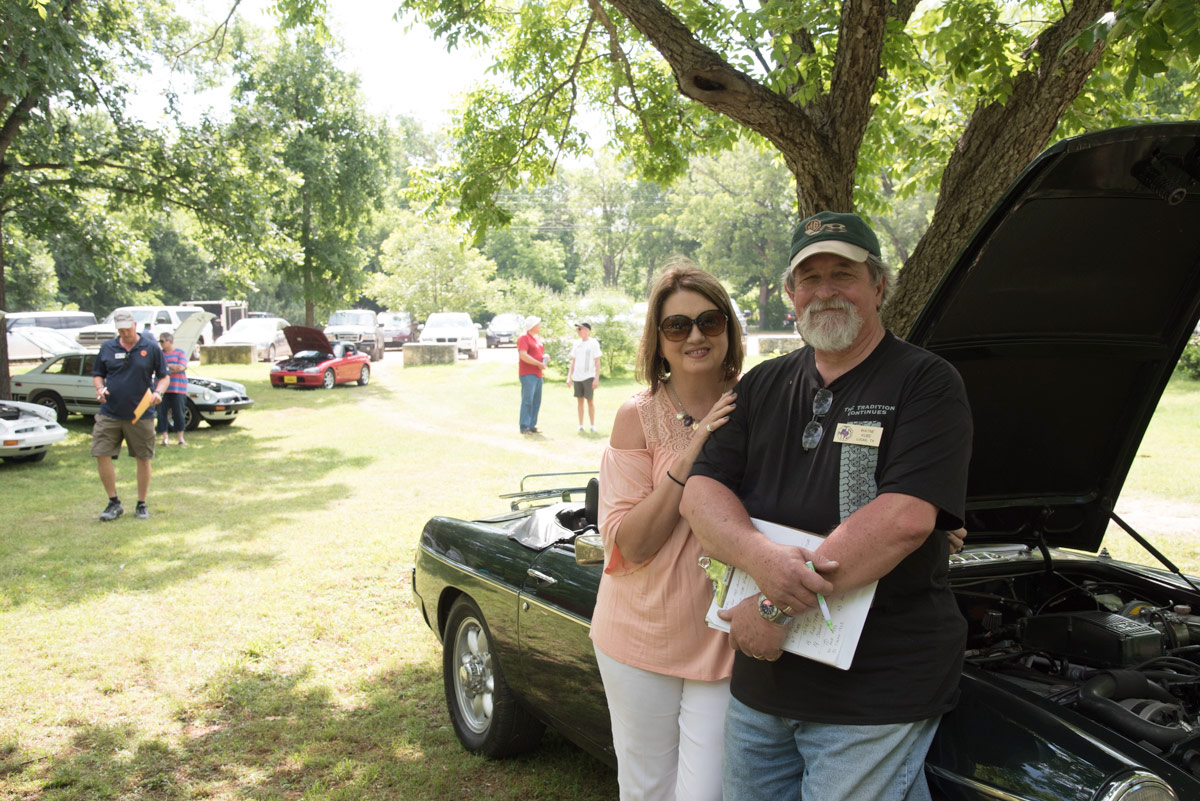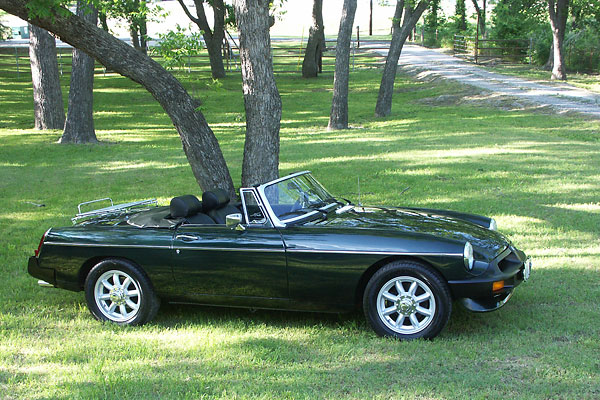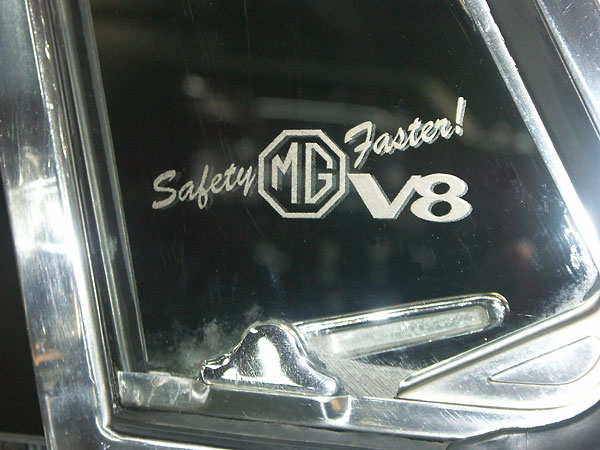
“My goal with this car was to not drastically alter the outside
appearance. I really didn’t want to have a bonnet bulge or hood
scoop, and I really like the idea of the 3.9L engine with fuel
injection, much in the line of the RV8. The only external
tell-tale of the V8 conversion is the dual exhausts and the
etching on the vent windows. And the sound, of course!
It took some tuning on a “rolling road” (chassis dyno) to get
the custom EFI optimized. The final result was 191 HP and 207
lbs/ft of torque at the rear wheels. That’s not way over the
top, but it’s certainly good enough for me right now.”
(as published in BritishV8 Magazine, Volume XVII Issue 1, July
2009)
Owner: Wayne Kube
City: Plano, TX
Model: 1979 MGB Roadster
Engine: Rover 3.5 V8
Conversion by: Wayne Kube, Mark Trosper & Nick Pappas
(a.k.a. “2nd Chance Garage”)
Engine: Rover 3.9L engine from a 1989 Range Rover, bored 0.020″
over and rebuilt. Rotating assemblies were balanced by Kim Barr
Racing Engines in Garland, TX. Crower cam (276°, 0.488″ lift.)
Delco distributor, custom curved by D&D, with a Pertronix
Ignitor electronic ignition and a 40,000 Volt Pertronix coil.
Bosch Platinum 4 plugs. MSD 8.5mm wires. Standard Rover fuel
injection manifold and plenum/throttle body (height reduced 1
inch.) MegaSquirt EFI system, which uses a MAP (manifold
absolute pressure) sensor in lieu of an airflow sensor. MGB GT
V8 valve covers.
Fuel System: new 5/16″ line up to the engine, and original MGB
1/4″ line to return surplus fuel back to the tank. I cut an
opening in the top of a new, unused tank, and installed an
in-tank swirl pot (home made) to ensure a steady fuel supply at
low fuel levels. The return line dumps back into the swirl pot.
Cooling: D&D Fabrications brass/copper radiator, 18″W x 15″H,
with 4 rows of half inch tubes. (If I’m out on the road and have
a radiator problem, just about anyone can repair a brass/copper
radiator. Not every shop can repair an aluminum radiator.)
Engine driven flex fan for primary cooling. If coolant
temperature reaches 185° F, the ECU engages a relay to power the
MGB fans in front of the radiator.
Exhaust: RV8-style headers routed to an x-pipe (all Jet-Hot
coated). 2 inch exhaust tubing throughout. Stainless Specialties
dual Mega-Oval mufflers. The fuel tank was centered to make room
for Pacesetter Monza dual exhaust tips with glass-packed
resonators at the rear. Transmission: T5 (“World Class”) 5-speed
from a V8 Camaro, with 0.63:1 top gear. D&D Fabrications
flywheel with Camaro 10.5″ clutch and pressure plate. D&D
shifter. The clutch is operated by a hydraulic throw-out bearing
from a stock MGB master cylinder.
Rear Axle: stock MGB (3.909:1) splined-hub axle. (I already had
Minilite-replica wheels, and didn’t want to give up that
appearance, so I kept this axle arrangement.) I considered
changing to a 3.07:1 axle ratio, but now I’m glad I didn’t
because I prefer the acceleration through the low gears that it
provides. In top gear I’m turning about 2,400 RPM at 70 mph, and
I can accelerate to pass or climb most grades without needing to
downshift. If I’d used the 3.07:1 ratio (like MG used on the MGB
GT V8 model and some MGC’s), my RPM at 70 mph would only be
about 1,800 rpm.
Front Susp.: standard MGB lever-arm shocks, but the oil was
drained and the shocks flushed with mineral spirits, then
replaced with 30-weight motorcycle fork oil. I’ve had this
combination in the car for over 10 years (through about 75,000
miles on the 4 cylinder engine) and it’s worked well for me.
With this V8 conversion, I up-sized the front sway bar to 7/8″
with the kit from Moss. The front suspension was lowered about 2
inches with a Moss coil spring kit.
Rear Susp.: lowered 2 inches with Moss lowered rear springs (not
the aluminum spacers that they now offer). Polyurethane bushes
and pads. I have a tube-shock conversion kit on the rear that I
purchased several years ago, but I changed to Monroe
air-adjustable shocks. During hard cornering, the 205/60-15
tires sometimes rubbed on the inner fenders, and the air shocks
reduced that problem. More recently, I’ve installed Mantell
Motorsports’ Panhard bar to further restrain sideways axle
movement. Note: I special ordered the Panhard bar with the
threaded ends not welded onto the bar so that I could easily
shorten it. This was necessary to accommodate both the disc
brakes and also a difference in how the Panhard bar mounts to
the “wire wheel” axle.
Brakes: standard MGB servo-assisted master cylinder.
(Front) slotted rotors and larger (TR8) pads.
(Rear) Scarebird disc brake conversion kit.
Wheels/Tires: 15×6 Minilite replicas, with 205/60R15 Dunlop
tires. Electrical: Painless Performance 18-circuit universal
wiring kit, with relays for ignition, headlights, driving
lights, and the electric fans. The only wiring components that
are still original MGB are behind the instrument panel. The
dashboard mounted gauges are original; the 4-cylinder tachometer
was modified and recalibrated for 8-cylinder operation. Saturn
85 amp alternator, wired so the in-dash “Ignition” lamp still
operates properly. Interior: black vinyl upholstery kit from
Victoria British. I applied half inch high-density foam to the
back of the carpet to reduce noise and heat. Moss electric seat
heaters. (My wife likes that!) Moss in-door courtesy lights.
Panasonic head unit with integral XM (satellite radio) tuner,
plus a 4×80 Watt amp mounted in the trunk. Four speakers, plus
tweeters mounted in the dashboard. The front speakers are
mounted in the kick panels and the rears are mounted behind the
door jams, just below where the top frame mounts.
Exterior: “Dark British Racing Green, Metallic” (actually, it’s
a Cadillac/Corvette color called “Polo Green 2”)
basecoat/clearcoat paint, applied over dark primer. Side marker
lamps removed. Early model (all red) taillights.
Completed: April 2008.
Weight: Original 4-cylinder 1.8L engine:
LF – 580 lbs, RF – 570 lbs, Subtotal – 1150 lbs (50.9%)
LR – 540 lbs, RR – 570 lbs, Subtotal – 1110 lbs (49.1%)
Total weight – 2260 lbs
Rover 3.9L EFI engine:
LF – 570 lbs, RF – 560 lbs, Subtotal – 1130 lbs (50.2%)
LR – 545 lbs, RR – 575 lbs, Subtotal – 1120 lbs (49.8%)
Total weight – 2250 lbs



